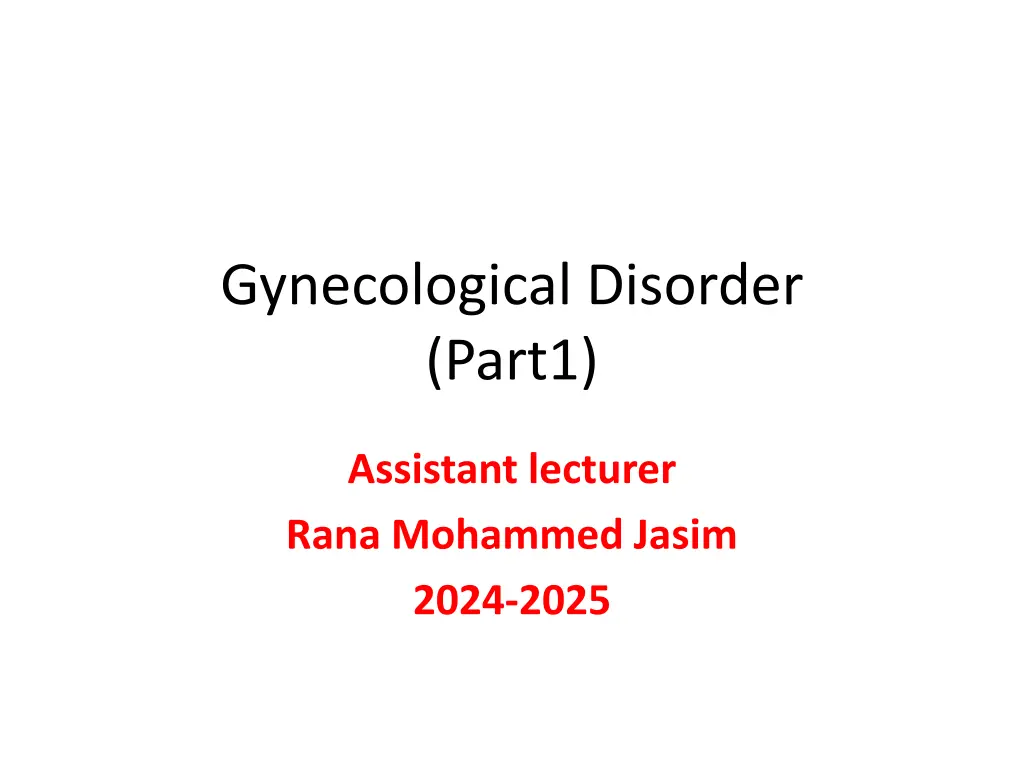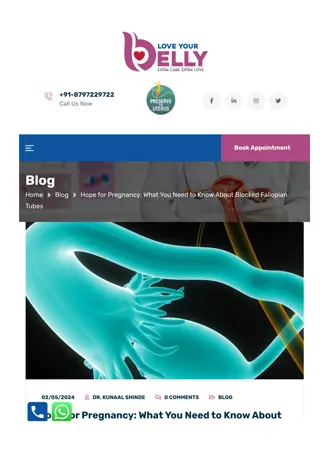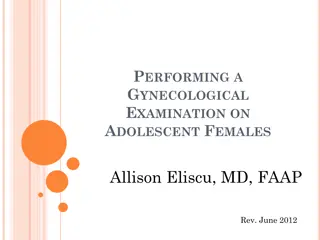
Understanding Prolapsed Uterus: Symptoms, Diagnosis & Treatment
Learn about prolapsed uterus, a common gynecological disorder affecting women, its symptoms like back pain and vaginal tissue protrusion, diagnosis through physical examination and imaging tests like ultrasound, and treatment options including pelvic floor muscle strengthening exercises.
Download Presentation

Please find below an Image/Link to download the presentation.
The content on the website is provided AS IS for your information and personal use only. It may not be sold, licensed, or shared on other websites without obtaining consent from the author. If you encounter any issues during the download, it is possible that the publisher has removed the file from their server.
You are allowed to download the files provided on this website for personal or commercial use, subject to the condition that they are used lawfully. All files are the property of their respective owners.
The content on the website is provided AS IS for your information and personal use only. It may not be sold, licensed, or shared on other websites without obtaining consent from the author.
E N D
Presentation Transcript
Gynecological Disorder (Part1) Assistant lecturer Rana Mohammed Jasim 2024-2025
Gynecological Disorder A gynecological disorder is a condition which affects the female reproduction organs, namely the breasts and organs in the abdominal and pelvic area including uterus, prolapse of the genital tract, benign or malignant genital tract, menstrual disorder, infertility.
Genital prolapse: The condition is most common in postmenopausal women who have had children, but can also occur in younger women and women who have not had children. occurs when pelvic organs (uterus, bladder, rectum) slip down from their normal anatomical position and either protrude into the vagina or press against the wall of the vagina. The pelvic organs are usually supported by ligaments and the muscles, connective tissue and fascia which are collectively known as the pelvic floor. Weakening of or damage to these support structures allows the pelvic organs to slip down.
Uterine prolapse: A uterine prolapse involves the descent of the uterus and cervix down the vaginal canal due to weak or damaged pelvic support structures.
Symptoms of a prolapsed uterus A feeling of fullness or pressure in your pelvis (it may feel like sitting on a small ball) Low back pain Feeling that something is coming out of your vagina Uterine tissue that bulges out of your vagina Painful sexual intercourse Difficulty with urination or moving your bowels Discomfort walking
Prolapsed Uterus Diagnosis The doctor need to examine in standing position and while are lying down and ask to cough or strain to increase the pressure in abdomen Specific conditions, such as ureteral obstruction due to complete prolapse, may need an intravenous pyelogram (IVP) or renal sonography. Dye is injected into your vein, and a series of X-rays are taken to view its progress through bladder. Ultrasound may be used to rule out other pelvic problems. In this test, a wand is passed over abdomen or inserted into vagina to create images with sound waves. Pelvic magnetic resonance imaging (MRI) is sometimes done if have more than one prolapsed organ or to help plan surgery.
Prolapsed Uterus Treatment Treatment depends on how weak the supporting structures around your uterus have become. Self-care at home can strengthen pelvic muscles by performing Kegel exercises. do these by tightening pelvic muscles, as if trying to stop the flow of urine. This exercise strengthens the pelvic diaphragm and provides some support. Medications Estrogen (a hormone) cream or suppository ovules or rings inserted into the vagina help in restoring the strength and vitality of tissues in the vagina. But estrogen is only for use in select postmenopausal women. surgery Depending on age and whether wish to become pregnant, Surgery can repair the uterus or remove it. When indicated, and in severe cases, uterus can be removed with a hysterectomy. During the surgery, the surgeon can also correct the sagging of the vaginal walls, urethra, bladder, or rectum. The surgery may be performed by an open abdominal procedure, through the vagina, or through small incisions in the abdomen or vagina with specialized instruments.
Follow-up Follow-up depends on how condition was treated. If had surgery, need to follow up according to surgeon's advice. If have a pessary inserted in vagina, it needs to be cleaned and checked by your health care provider for the correct position and fit at regular intervals unless you are instructed on how to remove it and clean it yourself at home. If have been told to do Kegel exercises, should have a regular follow-up visit so that your health care provider can check the progress of muscle strength.
Cystocele: A cystocele occurs when the tissues supporting the wall between the bladder and vagina weaken, allowing a portion of the bladder to descend and press into the wall of the vagina.
signs and symptoms of prolapsed bladder include: Pressure in the vaginal region vagina Pain in the vagina, lower back, abdomen or pelvic region Frequent urination or the urge to urinate Urinary incontinence or losing more urine than desired Difficultly using tampons Regular urinary tract infections No feeling of relief immediately after urination Pelvic pressure that worsens with standing, lifting or coughing Sexual intercourse might be painful Tissue protruding out of the
The primary cause of prolapsed bladder is childbirth. Obesity Heavy lifting Previous pelvic surgery Constipation Aging Menopause chronic coughing (or other lung problems) Excessive straining during bowel movements
Risk Factors Other common risk factors for prolapsed bladder are: Aging Family history Previous pelvic surgery
Diagnosis physical and pelvic exam. review symptoms, and family and medical history Cystourethrogram: This test is also referred to as a voiding cystogram. A Cystourethrogram is an X-ray of the bladder taken while a patient is urinating. The patient s bladder is usually filled with contrast dye to show the form of the bladder and reveal any obstructions. Magnetic Resonance Imaging (MRI): An MRI can help determine the scope of the condition.
Cystoscopy: This is a test that allows doctor to inspect the lining of bladder and the urethra, the tubular conduit that releases urine out of body. Urodynamics: This test demonstrates how well bladder is working and if there are any leaks or obstructions. Ultrasound: An ultrasound scan uses sound waves to capture images of bladder.
Cystocele treatment may include: Lifestyle changes: doctor may recommend that avoid or eliminate certain activities that could make your condition worse. Activities might want to avoid are lifting heavy objects or excessive straining during bowel movements. Kegel exercises: These are daily pelvic muscle exercises. Pessary: This is a medical device positioned in the vagina to stabilize the bladder. Bladder Prolapse Surgery: Surgery can reposition the bladder. doctor may insert a sling to hold bladder in place. Hormone replacement therapy: to strengthen the muscles throughout the vagina and bladder.
Urethrocele: A urethrocele occurs when the urethra (tube leading from the bladder to the outside of the body) descends and presses into the wall of the vagina. A urethrocele rarely occurs alone, instead usually accompanying a cystocele. The term cystourethrocele is used to refer to the prolapse of both part of the bladder and the urethra.
Cause: The urethrocele is held in place by a thick layer of muscle fibers and soft tissue, called the pelvic floor. However, certain situations may cause the pelvic floor muscles and tissues to lose their natural strength, causing them to stretch and become unable to hold the urethra (other structures of the female organ) in their original place. Once this occurs, the urethra, which is shaped like a tube, will widen and form a curve, until it starts to press into the vaginal wall.
Risk factors: Age -Age also plays a role in this process, as the muscles also naturally weaken as a woman ages. Congenital defects - There are some rare cases in which young women who have never had any children suffer from this weakening of the pelvic muscles, as well as some cases wherein a urethral prolapse may already be present even at birth. Both cases are caused by congenital defects in the pelvic floor. Obesity Repetitive activities causing pressure to the pelvic floor, such as lifting heavy objects frequently Health conditions that cause repetitive strain on the pelvic muscles, such as chronic cough or chronic constipation Hysterectomy (surgery to remove the uterus)
Treatment involves: Kegel exercises Doing Kegel exercises is an effective way to strengthen the pelvic floor muscles, and this can help improve the patient s condition and reduce symptoms. To do Kegel exercises, simply contract and release the pelvic muscles repeatedly. These are the same muscles that control the flow of urine. Surgery In some severe cases, urethrocele may be treated with surgery, in which the supporting structure surrounding the urethra is repaired. Rectocele: A rectocele occurs when the tissues supporting the wall between the vagina and rectum weaken allowing the rectum to descend and press into the wall of the vagina.
Rectocele: A rectocele occurs when the tissues supporting the wall between the vagina and rectum weaken allowing the rectum to descend and press into the wall of the vagina.
Symptoms mild cases of rectocele, the individual may notice Trusted Source pressure within the vagina, or they may feel that their bowels are not completely empty after using the bathroom. 7 In moderate cases, an attempt to evacuate can push the stool into the rectocele rather than out through the anus. There may be pain and discomfort during evacuation. There is a higher chance of having constipation, and there may be pain during sexual intercourse. Some say it feels as if something is falling out or down within the pelvis. In severe cases, there may be fecal incontinence, and sometimes the bulge may prolapse through the mouth (opening) of the vagina, or through the anus
The following are risk factors: a drop in estrogen levels at menopause, making pelvic tissues less elastic a hysterectomy or other pelvic surgery chronic constipation long-term coughing, such as in chronic bronchitis sexual abuse during childhood being obese or overweight regularly lifting heavy objects
Treatment Depending on how severe the rectocele is, a doctor may suggest home remedies, medication, or, in some cases, surgery. Enterocyte: An enterocyte is similar to a rectocele, but instead involves the Pouch of Douglas (area between the uterus and the rectum) descending and pressing into the wall of the vagina. Vaginal vault prolapses: A vaginal vault prolapse occurs when the top of the vagina descends in women who have had a hysterectomy.






















